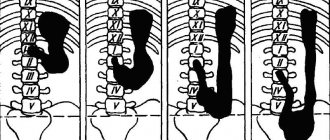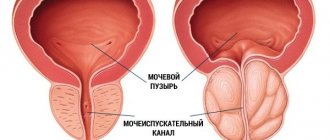Paraproctitis is inflammation of the tissues near the rectum (pararectal tissue) due to the penetration of infection into them. An abscess (a limited space with purulent contents) often forms acute paraproctitis . An abscess of perirectal tissue can break out on its own, but the process often becomes chronic, forming rectal fistulas (chronic paraproctitis) .
Paraproctitis is one of the most common proctological diseases, the only more common ones are hemorrhoids, anal fissure and colitis. The most common causes of paraproctitis are infection of the perirectal tissue, most often through the rectal mucosa (microtraumas and cracks in the mucosa due to constipation, hemorrhoids, etc.). d.).
What is the treatment for paraproctitis?
Treatment of paraproctitis involves making an incision in the skin near the anus to remove pus from the infected cavity and reduce the pressure inside it. Quite often this can be done on an outpatient basis using local anesthesia. Treatment of large or deep abscesses may require hospitalization in a specialized hospital that can provide adequate pain relief during surgery. Hospitalization is indicated for patients with a tendency to serious infectious complications (patients with diabetes mellitus and decreased immunity). Conservative (non-surgical) treatment with antibiotics alone is not as effective as drainage (removing pus). This is due to the fact that antibiotics cannot penetrate the abscess cavity and act on the purulent contents located there.
Reasons for development
There are many factors that can contribute to the development of pathology. Among them:
- Frequent bowel disorders or constipation
- Infectious bowel diseases, E. coli
- STD
- Haemorrhoids
- Traumatization of the rectum
- Untreated anal fissures
- Colitis
- Crohn's disease
- Decreased immunity
- Poor nutrition – predominance of fatty and spicy foods in the menu
- Alcohol abuse
- Specific physical activity, lifting heavy objects
- Failure to comply with hygiene standards
The combination of reasons determines the main category of patients of the proctologist - most often men aged 25-50 years turn to the doctor with paraproctitis.
What is the treatment for rectal fistula?
Treatment of rectal fistula is only surgical. Despite the fact that many options for surgical treatment of rectal fistulas have been developed, the likelihood of complications remains quite high. Therefore, it is preferable that the operation be performed by a coloproctologist (colorectal surgeon). Simultaneous treatment of fistula and paraproctitis is possible, although usually the fistula develops in the period from 4 to 6 weeks after drainage of the abscess, in some cases it can occur months and years later. The main principle of surgical treatment of rectal fistulas is the opening of the fistula tract. This is often accompanied by excision of a small portion of the anal sphincter, i.e. muscle that controls stool retention. Connecting the internal and external openings, opening the fistula tract and transforming it into an open state allows for rapid healing of the resulting wound in the direction from the bottom to the edges. Often, surgical treatment of rectal fistulas can be performed on an outpatient basis. However, treatment of deep or widespread fistulas may require hospitalization.
Consultation with a proctologist
Any suspicion of paraproctitis is a reason for immediate contact with a proctologist and immediate surgery if the diagnosis is confirmed. If treatment is not carried out or the source of infection is not eliminated, paraproctitis becomes chronic and a fistula tract is formed over time. During the consultation, the proctologist will conduct a diagnosis through palpation and visual examination. Determine the severity of the condition and recommend the most effective way to combat the disease.
How long does the healing process take?
In the first week after surgical treatment of a fistula, the patient may experience moderate pain, which can be controlled with painkillers. The period of forced disability is minimal. After surgical treatment of a fistula or paraproctitis, a period of follow-up treatment at home is necessary using sitz baths 3-4 times a day. It is recommended to add dietary fiber or laxatives to the diet. To prevent contamination of underwear, you can use gauze bandages or pads. Normal stool has no effect on wound healing.
Publications in the media
Acute paraproctitis (AP) is a fistulous form of abscess of peri-rectal tissues. The primary inflammatory focus is localized in the anal crypts (acute anal cryptitis). Subsequently, pus spreads through the ducts of the anal glands. The predominant age is 20–60 years; it occurs rarely in children. The predominant gender is male (7:3). Classification • By localization of abscesses, infiltrates, leaks: •• Submucosal - located under the mucous membrane of the rectum •• Subcutaneous - located under the skin of the perianal region and anal canal •• Ischiorectal (ischiorectal) - located below the levator ani muscle; accessible to palpation •• Pelviorectal (pelviorectal) - located above the levator ani muscle; •• Posterior rectal (retrorectal) - located in the presacral tissue• By the nature of the infection: •• Vulgar AP •• Anaerobic AP •• Specific AP (tuberculous, syphilitic, actinomycotic). Etiology and pathogenesis • Penetration of infection into the perirectal tissue from the ducts of the anal glands. The connection of the abscess with the rectum causes constant or periodic infection of the perirectal tissue • Microtrauma of the mucous membrane of the rectum and anal canal by undigested food particles, dense lumps of feces, foreign bodies; microtraumas are also possible as a result of therapeutic manipulations - enemas, pararectal procaine blockades, injections of sclerosing drugs • Hematogenous and lymphogenous routes of infection into pararectal tissue (rarely) • Mixed microflora: staphylococcus and its associations, gram-negative and gram-positive rods and their associations, monobacterial flora • Specific APs due to tuberculosis, actinomycosis, and syphilis are characterized by a torpid course and an infiltrative type of spread.
Risk factors • Constipation or prolonged diarrhea • Prolapse and strangulation of hemorrhoids • Inflammatory diseases of the rectum (nonspecific ulcerative proctitis, Crohn's disease) • History of perirectal abscess. Pathomorphology • Inflammation of the Morganian crypt and anal glands • Inflammation of the cellular spaces with the formation of purulent cavities • Inflammatory infiltration and cicatricial changes around the ulcers and along the communication with the lumen of the rectum, in the long term - epithelization of the fistulous tract.
Clinical picture • Subcutaneous AP •• Rapidly increasing pain in the perineum, at the anus •• Increased body temperature (in the evening 38–39 ° C) •• Retention of stool; when the abscess is located in front of the anus - dysuria •• Palpation of the inflammatory infiltrate - sharp pain, fluctuation •• Pain during digital examination of the rectum. Pain and induration on endorectal palpation of the crypt, which was the source of AP. • Submucosal AP •• Moderate pain in the rectum, aggravated by defecation •• Low-grade body temperature •• Pus can break into the lumen of the rectum, in this case the disease ends in recovery •• Digital examination of the rectum - a painful rounded tight-elastic formation located under the mucosa shell above the dentate line. • Ischiorectal (ischiorectal) paraproctitis •• The disease begins gradually, there is a deterioration in general condition, weakness, sleep disturbances •• Later, a feeling of heaviness and constant sharp pain in the rectum and deep in the pelvis appear •• Body temperature rises to 39–40 ° C, chills •• When the inflammatory process is localized in the area of the prostate gland and urethra - dysuric disorders. • Pelvic-rectal (pelviorectal) AP •• Deterioration of general condition (fever, chills, weakness, loss of appetite) in the complete absence of pain. The duration of this period is 1–3 weeks •• With the appearance of an abscess, the disease takes an acute course: dull pain in the rectum and deep pelvis, accompanied by intoxication, hectic body temperature, stool retention, tenesmus •• Diagnosis - digital examination of the rectum. • Posterior rectal (retrorectal) AP •• From the very beginning of the disease, severe pain syndrome localized in the rectum and sacrum appears, intensifying with defecation and in a sitting position, dysuria •• Digital examination of the rectum - a sharply painful bulge in the area of its posterior wall. Laboratory research. CBC (leukocytosis, shift of the leukocyte formula to the left), bacterial examination of the purulent contents of the abscess, pathohistological examination of the scar tissue of the abscess capsule. Special studies • A test with a dye allows you to detect the connection of the abscess cavity with the intestinal lumen by puncture filling it with dye (usually 1% methylene blue solution) after preliminary emptying of pus • Probe test - passing a metal button probe through the abscess cavity into the intestinal lumen through the existing communication in order to detect the entrance gate of infection, as well as to establish the relationship of the fistulous tract to the sphincter fibers.
Differential diagnosis • Suppuration of pararectal dermoid cyst • Tumor of the sacrum • Abscess of the pouch of Douglas • Suppuration of the epithelial coccygeal tract • Purulent-inflammatory diseases of the skin of the perineum (abscess, boil, suppurating atheroma). TREATMENT. The main method is surgical. The operation must be performed immediately after diagnosis. The diet is easily digestible and slag-free. After surgery, a diet rich in plant fiber and plenty of fluids is prescribed. Regimen • Hospitalization in the department of purulent surgery or coloproctology to perform surgery under general anesthesia • The regimen of patients after surgery is generally active, but depends on the method of the operation performed.
Surgical treatment • The main surgical technique at present is opening the purulent cavity into the intestinal lumen. • Stages of the operation: opening of the abscess with an incision tangential to the fibers of the anal sphincter, revision of the purulent cavity, identification of communication with the “causal” crypt, excision of the affected crypt (cryptectomy) and tissue along the fistula according to the Gabriel operation, drainage of the wound. The wound in the anal canal and perianal area after radical opening of the OP into the intestinal lumen, as a rule, has the appearance of a “keyhole”. However, the configuration of the incisions in the perineum and in the anal canal may vary depending on the presence of purulent leaks. • In case of high transsphincteric and extrasphincteric communication of the purulent cavity with the lumen of the rectum, two-stage surgical treatment is possible, and at the first stage only the opening and drainage of the abscess cavity from the semilunar incision in the perineum is performed. Subsequently, after the formation of a fistula, surgical treatment is carried out as planned (see Chronic paraproctitis). In case of submucosal paraproctitis, the purulent cavity is opened from the lumen of the rectum with a linear vertical incision, also with excision of the affected crypt. With severe retrorectal and pelviorectal paraproctitis, infection may spread through the pelvic tissue spaces (pelvic cellulitis, retroperitoneal phlegmon). In such cases, additional drainage of the pelvic and retroperitoneal spaces is performed. Management in the postoperative period • Postoperative treatment after radical (or palliative) surgery must be carried out taking into account the phases of the wound process: in the first phase, before cleansing the wound surface, sorbents (application sorption), hydrophilic ointments (for example, Levosin) are used, and in the second, when granulations appear, fatty or jelly-like ointments are effective • Local ozonation, laser and UV irradiation of the surface of wounds, ultrasonic cavitation are effective • On the 3rd day after surgery, the patient is prescribed 20–30 g of castor oil during the day and at night.
Drug therapy • Antiseptics: solutions of hydroxymethylquinoxylindioxide, hydrogen peroxide, nitrofural, aqueous solution of chlorhexidine • Suppositories with methyluracil • Ointments “Levosin”, “Actovegin” • Vaseline or castor oil orally • Antibacterial agents are indicated for severe general reactions (intoxication syndrome with high body temperature), as well as in patients with diabetes. Outpatient observation . Regular physical examination in the postoperative period until the postoperative wound is completely healed and the function of the anal sphincter is restored. Complications • After the usual opening of an abscess during AP, without eliminating its internal opening, 30–50% of patients subsequently develop rectal fistulas or relapse of AP • Insufficiency of the anal sphincters (associated with the suppurative process affecting the anal sphincters, or the surgical technique) • Recurrence of the abscess if the “causal” crypt was not excised. Current and prognosis . Long-term results depend on the form of AP, timing and methods of surgical intervention. Prevention • Prevention of constipation • Hygiene of the perianal area • Early diagnosis and timely treatment of purulent-inflammatory diseases of the pelvic organs • Compliance with the technique of performing enemas and other transanal medical procedures. Age characteristics • Children. Occurs more often in newborns and infants • Elderly. Often occurs against the background of chronic colostasis. Synonyms • Anorectal abscess • Cryptoglandular abscess Abbreviation. OP - acute paraproctitis
ICD-10 • K61 Abscess of the anus and rectum.
Classification
There are several divisions. According to the activity of inflammation, paraproctitis can be:
- acute (symptoms are clearly expressed)
- infiltrative (with infiltration of nearby tissues)
- chronic (fistulas, that is, holes, form; surgery is needed)
At the location of the inflammation, an abscess can be:
- under the skin
- under the mucosa
- pelvicorectal
- ischiorectal
According to the location of the internal opening of the fistula:
- lateral
- front
- rear
The depth of tissue damage may also vary. The following types of paraproctitis are distinguished:
- surface
- deep
Diagnostics
Diagnosis of any type of inflammation of the perirectal tissue includes confirmation of the diagnosis based on existing symptoms, as well as differentiation of pathology from other proctological anomalies:
- teratomas of perirectal tissue;
- abscess of Douglas space;
- rectal tissue cysts;
- osteomyelitis of the lower spine;
- epithelial coccygeal duct;
- tuberculous fistulas and fistulas due to Crohn's disease.
To confirm paraproctitis, in addition to collecting anamnesis and complaints, use:
- laboratory blood test (a purulent process is indicated by an increase in leukocytes, neutrophils and ESR);
- physical examination of the rectum and perianal area (digital examination);
- anoscopy and sigmoidoscopy (these types of studies are not used for acute inflammation due to their pain and risk of sphincter spasm);
- canal probing or fistulography (x-ray contrast study);
- X-ray of the pelvic organs with or without contrast.
Diagnostic data helps to detect a purulent focus and all its ducts in order to choose the right treatment tactics.
General information
In proctology, acute paraproctitis is understood as an inflammatory process that arose in the peri-rectal tissues for the first time. The disease is an infectious pathology, accompanied by the formation of a cavity filled with pus in the tissue, which later opens into the pararectal area. Externally, it may look like a large abscess near the anus, very rarely on the buttock or inner thigh.
Chronic forms of paraproctitis occur with poor quality treatment or lack thereof. After their independent opening, the duct is scarred, the external opening is closed, but the purulent focus remains. Until it fills with exudate, the symptoms subside, and after the accumulation of pus, the process repeats.
In chronic paraproctitis, fistulas are formed - non-healing ducts, one end of which opens into the rectum, or rather in the bottom of the crypt (the depression next to the rectal sphincter, where mucus is synthesized to facilitate defecation), and the second - into the ampulla of the rectum, the perianal area, to the surface thighs or buttock, into nearby hollow organs (intestines, bladder, uterus, prostate).
The only way to eliminate paraproctitis, regardless of its form and stage, is surgical opening of the abscess, followed by drainage of the purulent cavity and suturing of the ducts.








